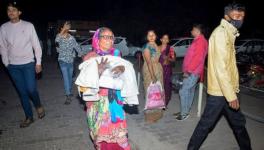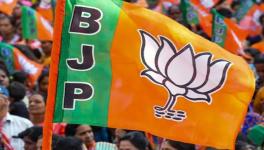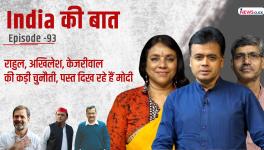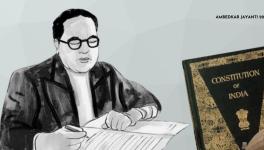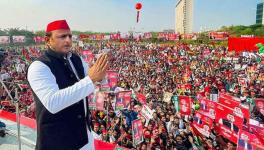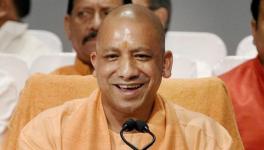In Caste-Ridden Uttar Pradesh, is Ghosi By-poll Signal for 2024?
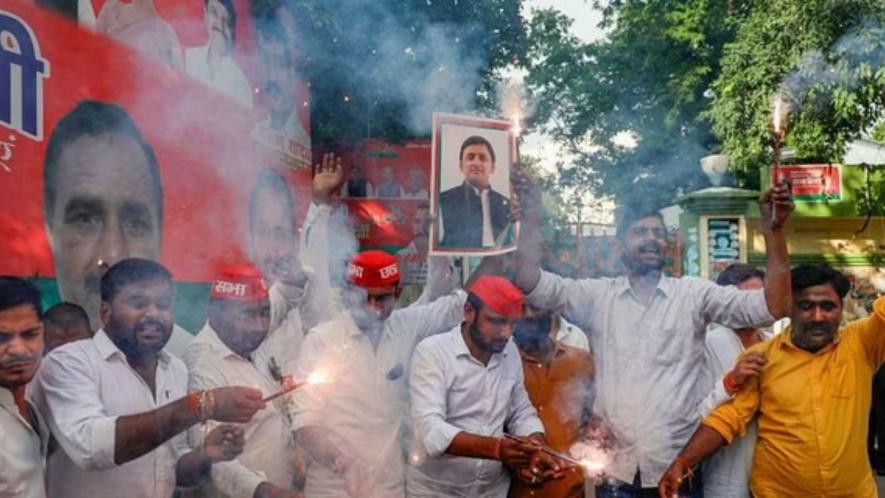
Samajwadi Party workers celebrate the victory of party candidate Sudhakar Singh in the Ghosi constituency by-election, in Lucknow, Friday, Sept. 8, 2023. Image Courtesy: PTI
The Bharatiya Janata Party’s loss in the Ghosi by-poll in Uttar Pradesh has cast a shadow of doubt over the ministerial prospects of its losing candidate Dara Singh Chauhan and ally Om Prakash Rajbhar. With eight ministerial spots still vacant in the Yogi Adityanath council of ministers, the ruling party is expected to carry out a Cabinet expansion as the 2024 Lok Sabha election draws near. However, with Chauhan’s defeat and Rajbhar left red-faced, as he had just returned to the BJP-led National Democratic Alliance and promised to deliver the seat to his ally, questions are being raised if the two would make it to the Adityanath Cabinet.
Talking to the media, Rajbhar, the president of the Suheldev Bharatiya Samaj Party or SBSP, on Sunday expressed confidence that the defeat would not hurt his ministerial prospects. “[Go, tell the Opposition people] to hold their hearts, lest they get a heart attack. Will definitely become [a minister]. Why won’t I,” Rajbhar said in Ballia. Both Rajbhar and Chauhan served as Cabinet ministers in the first Yogi Adityanath government.
If indeed Rajbhar, a legislator from the Zahoorabad constituency in Ghazipur, and Chauhan get inducted into the Adityanath ministry, it would be part of a trend where leaders from the backward castes get an increased presence in the second term of the BJP, even though the elite castes continue to enjoy power posts way above their share in the population of the state.
With the main Opposition Samajwadi Party led by former chief minister Akhilesh Yadav breathing down the BJP’s neck with renewed focus on social justice politics and demands for a caste census, the saffron party is expected to further guard its backward-caste voters.
An analysis of the Adityanath council of ministers for NewsClick, shows that out of 52 ministers, the Other Backward Classes (OBC) and ‘elite castes’ occupy 21 berths each, which is 40.38% each. With nine ministers, Dalits hold 17.3% of the posts in the council of ministers. There is a lone Muslim minister.
Let us compare this with the caste composition of the Adityanath council of ministers during his first term. In September 2021, months before the 2022 Assembly election, the Adityanath council of ministers reached its maximum allowed strength of 60. At the time, it had a higher percentage of elite castes. Out of the 60 ministers, 45% (or 27) belonged to an ‘upper caste’, 38.33% (or 23 ministers) were from the backward communities, and 15% (or nine) were Dalits. The last government, too, had a single token Muslim minister.
It is significant that the OBC Hindus are the single largest bloc in Uttar Pradesh, estimated to be between 40 and 45% of the population. The Dalits make up 21.5% of the population while Muslims are 19.5%. Elite castes such as the Brahmins, Thakurs, Baniyas, Kayasthas and Khatris make up the rest.
The second term of Adityanath (beginning March 2022) also has had a greater percentage of backward castes holding Cabinet portfolios than they had during his first tenure from 2017 to 2022. However, here too, the upper castes continue to enjoy power disproportionate to their share in the population.
As of today, out of the 18 Cabinet ministers in Uttar Pradesh, including the Chief Minister, 50% (or 9) are upper caste, while the backward castes are just behind, at 44.44% (8). The Dalits have a minuscule share of only 5.5% or 1 Cabinet berth.
By contrast, in September 2021, out of the 24 Cabinet ministers, an overwhelming 66.66% (or 16 in number) belonged to an elite caste. Backward caste leaders made up 29.16% (or seven members) of the Cabinet, while the Dalits had just one—a share of 4.1%.
The increased presence of the OBCs in the BJP’s ministry coincides with the Samajwadi Party’s thrust towards backward caste and Dalit-centric politics in contrast to Yadav’s development-oriented “Kaam Bolta Hai—Our Work Speaks for Itself” narrative when he was defending power in 2017.
In the 2022 election, the Samajwadi Party did not just stitch key alliances with smaller parties with a support base among the backward classes such as the Rajbhars, Mauryas, Kurmis, Chauhans and Jats, it also changed the language of its messaging. To blunt the BJP’s strategy of dubbing the Samajwadi Party as representing the interests of only the members of the Yadav caste, to which Akhilesh Yadav belongs, he incorporated leaders and ideas from the Bahujan stream of politics.
As Akhilesh Yadav challenged the BJP through a “pichdon ka inquilab—revolution of the downtrodden”, he promised backward-community voters that if he was voted to power in Uttar Pradesh his government would carry out a caste census and provide them “rights, honour and representation”. Most importantly, he promised that representation would be as per their share in the population relative to other Hindu communities. This echoed the politics of Bahujan Samaj Party (BSP) founder Kanshiram, who popularised the clarion slogan for OBCs and Dalits to challenge the dominance of the elite castes, “Jiski jitni sankhya bhari, uski utni hisseydari.”
Despite losing the 2022 election, the Samajwadi Party and its allies made a huge improvement in seat tally, winning 125 seats in the 403-member Assembly, and giving the BJP a tough time in the Purvanchal region, where most of its OBC allies were based.
The BJP got a second consecutive majority, although with a reduced margin. In 2017, the NDA had won 325 seats in the Assembly, while in 2022 this dropped to 273.
Perhaps factoring in the flux in backward class politics, the BJP government had provided an increased representation to members of such communities when it came to power again. The 18 Cabinet ministers in this government include Deputy Chief Ministers Keshav Prasad Maurya (an OBC) and Brijesh Pathak (a Brahmin) and BJP allies Sanjay Nishad, an OBC and president of the Nishad Party or Nirbal Indian Shoshit Aam Dal, and Ashish Patel, a backward community leader of the Apna Dal (Soneylal), which is led by his wife, Union Minister of State Anupriya Patel.
A caste-wise breakup of the nine elite-caste Cabinet ministers shows three are Brahmin, two Thakurs, two Bhumihars, and a Khatri and Baniya each. Overall, Brahmins and Thakurs are the single-largest represented castes in the Adityanath council of ministers with seven members each. Among the backward communities, the Kurmis have the highest representation with four ministers followed by three Jats, three Nishad-Kashyap castes, two Lodh Rajputs and two Maurya-Sainis.
The Gurjar, Teli, Yadav, Prajapati, Pal, Kalwar and Rajbhar castes have one minister each, too.
When it comes to the Dalits, the Jatavs have three ministers—Baby Rani Maurya, Asim Arun and Vijaya Laxmi Gautam. The Jatavs make up 56% of the Dalit population in Uttar Pradesh and are considered the core vote bank of the BSP. However, with the shrinking of Mayawati’s popularity and successive defeats, both the Samajwadi Party and the BJP have been trying to lure the community’s votes.
The Gond (Scheduled Tribe) and Dhobi, Khateek, Kori, Pasi and Valmiki Scheduled Castes have one minister each. In 2022, the BJP and its allies won 65 out of 86 seats reserved for the Scheduled Castes and Scheduled Tribes while in 2017 it had won 76 of these seats.
The BJP’s strategy in Uttar Pradesh over the last few years has focused on isolating Muslim and Yadav voters while reaching out to what it calls the “non-Yadav OBCs”, and the “non-Jatav Dalits” and the elite castes. The BJP routinely claims, without any evidence to substantiate, that the previous Samajwadi Party government appeased Muslims and showered the Yadavs with the cream of entitlements, privileges, shares in jobs and government while leaving the other backward communities under-represented and without a share in the pie. Through this they attempt to mobilise the rest of the Hindu communities on an anti-Yadav and anti-Jatav sentiment, mostly the former.
This is a major reason why the BJP fields very few Yadavs even though they are the single-largest OBC caste in the state, around 20% of the backward population, according to the 2001 social justice report headed by the late Hukum Singh. In both Yogi 1.0 and 2.0, there has only been a single Yadav minister. Since the BJP does not field Muslim candidates in Assembly elections, it has more room to accommodate backward classes and Dalits in its government unlike the Samajwadi Party and BSP governments of the past.
For instance, the Akhilesh Yadav council of ministers when it had a strength of 48 as on March 20, 2012, had 10 Muslims and nine Yadavs.
Uttar Pradesh Deputy Chief Minister Keshav Prasad Maurya has best described the BJP’s strategy of isolating Yadavs, Jatavs and Muslims, who together make up 40% of the state’s population, while weaning away some of the first two communities through Hindutva. “Sau mein 60 hamara, 40 mein batwara hai, aur batware mein bhi hamara hai—We have 60% votes, the remaining 40% are divided and even there we have a share.”
To counter this, Akhilesh Yadav has resorted to the PDA or Pichda Dalit Alpsankhyak narrative of uniting backward castes, Dalits and Muslims and spoken aggressively on caste census. As we head to the 2024 Lok Sabha, the task of cutting into the BJP’s OBC votes remains a challenge for the Samajwadi Party as the BJP also has with it three small OBC-based allies—the SBSP, the Nishad Party, and the Apna Dal (Soneylal). In contrast, since losing the 2022 election, Yadav lost the support of the SBSP and the Mahan Dal, which has support among the Maurya-Shakya-Saini communities. However, the by-poll defeat in Ghosi for the BJP, despite firing all cylinders and deploying its entire OBC contingent, has raised hopes in the Opposition.
The author is an independent journalist. The views are personal.
Get the latest reports & analysis with people's perspective on Protests, movements & deep analytical videos, discussions of the current affairs in your Telegram app. Subscribe to NewsClick's Telegram channel & get Real-Time updates on stories, as they get published on our website.










